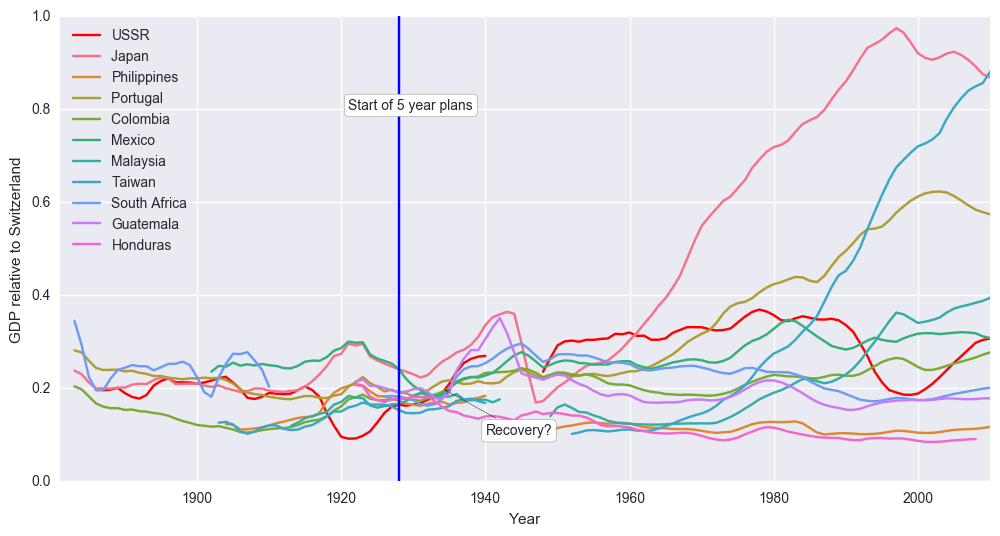The Soviet Union: From farm to factory. Stalin's Industrial Revolution
[This post is part of the Soviet Series]
In 1922, the relatively young Soviet Union was a relatively poor country recently afflicted by a civil war and a revolution. After the Second World War, the USSR was a superpower capable of stopping Germany's Wehrmacht on its tracks[1]. What happened there?
Given the title, it won't come up as a surprise that Stalin happened. This post will analyse the impact of Stalin on Soviet growth, beginning with a presentation of some statistics regarding Stalin's achievements, then some theory of how that growth was achieved, then some discussion about that. We will mostly draw from Robert Allen's From Farm to Factory initially, and then discuss later work. This post assumes that you have read the book. A summary of it can be found in Allen (2005), read it first just in case.
Index
- Feldman's model
- GDP growth
- Book reviews
- Tsarist growth
- Recovery from the war?
- A drop in civilian R&D?
- Some counterfactuals
- Conclusion
1. Feldman's model
In a nutshell, Stalin's approach is summarised by what Allen calls Feldman's model: Investing in capital goods now leads to a greater availability of consumer goods in the future, even when that may lead to a drop in consumer goods today. It is just an extension of the fact that there is a tradeoff between consumption and investing, and that investing typically has positive returns. Thus if you invest more today you'll consume less today, but you'll consume even more in the future. As simple as that.
So the issue then is how to increase those savings. In a market economy, people's decisions about their individual tradeoffs yield an aggregate social rate of savings. In a planned economy, a national savings rate is set, and plans are issued for individuals to adapt to it.
Adapt to it means coercing people into saving more, and people in the early Soviet context means peasants. For marxists, capitalism's origin lies precisely in exploitation: primitive accumulation of capital. As socialism was supposed to take over capitalism after a point where plenty of capital was already available, early Soviet leaders, within their framework, saw that they had to comply with the laws of history they themselves professed to hold as true, and so for them exploiting peasants was seen as something almost necessary and unavoidable.
There were debates about how would to best to implement the plan, and Allen doesn't discuss those in depth (Alec Nove does, in his book). In the end, the policy that won was, of course, Stalin's: the State would buy produce from peasants and sell to them at prices such that the State pocketed a hefty premium. There are some debates about the origin of Stalin's proposal. The consensus is that it originated not in Stalin himself, but in economists Feldman and Preobrazhenski, and that the goal was indeed to produce more consumer goods through building heavy industry first. However, perhaps that interpretation is not that true, as there is evidence suggesting Stalinism was about heavy industry for the sake of military buildup, not so much future consumption (Kontorovich, 2016). Regardless, the reason for Stalinist policies is not what matters here, but what they caused.
Before further analysis, I will foreclose one interpretation that some people have made of Allen's book: that Stalinism works in the sense that it is superior to the system now present in advanced economies. This is false, and Allen does not endorse this. The claim made in the book is more specific: That compared to the alternatives in the institutional setting of 1917 Russia, Stalinism delivered higher growth. Stretching the claim, one could say that it can be deduced from Allen that Stalinism is a viable development model for other countries, especially in the Third World.
2. GDP growth
In a previous entry in The Soviet Series, I made some remarks regarding GDP growth. You can see them here. I made a few more plots to complement the ones there, including some sensitivity analysis for Allen's regression. Shortly put, the issue with Stalinism is that it began just after a war, and GDP growth is faster after wars, not because of the war itself, but because the war has disrupted the economy and people still remember how it used to be and easily move back to that. [2]. In another section, I address this issue.
First, the most obvious and needed chart (All the data comes from the Maddison Project):
You can see that one could make the case that recovery didn't happen until around 1938, and so we should start counting from there. In Allen's regression (see previous link), he takes the growth of GDP between 1928 and 1970 and shows that the USSR did well by that standard. The issue is that such calculations are highly sensitive to the years you choose. As a sample, have a look at this

Compare for example the picture you get from the base 1922 or base 1928 cases with the other two, a few years later. The picture is much, much different. The countries chosen in each picture are the countries that had the same GDP per capita as the USSR in each base year, +/- 600 international dollars. Another way of seeing this is to see how the ratio of 1980 GDP to base year GDP changes as we consider different base years.
(Countries here are chosen just for comparison)
One of the most intuitive ways of assessing growth is comparing growth against one of the richest countries. They represent the frontier of achievable wealth, and a baseline of growth. In this case I've chosen Switzerland for my comparison rather than the US, the reason being that Switzerland remained neutral during the wars and thus its GDP growth is more stable than the US's.
Here we see that compared to countries that had a GDP simmilar to that of the USSR in 1928. Someone might not even wonder whether the USSR was a failure. Which country should we use as a comparison? Should we compare Russia to western countries, to Third World countries or neither? Allen discusses this in the book, and it is a complicated question.
Bill Easterly (1995) tried to resolve the issue by slightly changing the question and recasting it as a problem of running a multivariate regression. The question becomes: Given an average country of its characteristics, where would we expect the USSR to be? And then we can compare that with the actual empirical results. This is what Allen did with GDP. But might other variables explain Soviet growth? Easterly considers education, initial income, population growth, secondary school enrolment, and investment/gdp ratio. The result of that analysis is that central planning reduced growth by 2.43 percentual points per year. That is, the USSR should have been growing at a rate of 4.7% yearly, and instead it grew at 2.36%. But Easterly considers the 1960-89 period, and Allen argues that the system stopped working well after 1970. We should then run the regression between 1928 and 1970. Here's my point in yet another chart:
So the reconciliation of Allen and Easterly is simple: Both can be right as they covered different time frames, and the optimal growth path purely in terms of GDP for Russia could have been Stalinism followed by gradual marketisation in the 60s or 70s. Looking for data to do the regression myself is outside of the scope of this post, though perhaps the data is around somewhere to do it.
One last remark: In Easterly's regression, the biggest explanatory variables to explain growth are secondary school enrolment and investment ratio to GDP. Both are easy to control coercively, which is what was done: restricted consumption to increase investment and compulsory education for all. But of course, it can be argued, without central planning they would have been lower. The high investment situation without communism was not a viable path after Tsarist Russia, is what Allen is arguing: they would have remained in a slow growth equilibrium. Also, was it worth it in terms of welfare? [3]
There is some counterfactual work to do regarding this: What would the Tsarist economy have growtn in the absence of the revolution? Something about this might appear at Pseudoerasmus' blog at some point.
3. Book reviews
After the publication of the book, a number of economic historians published review of it. Here I will discuss those of Michael Ellman, Paul Gregory, Mark Harrison, and Robert William Davies.
Ellman (2004) is quite sceptical right from the beginning of his essay, noting that Allen goes against established knowledge (The book is called a Reinterpretation of the Soviet Industrial Revolution for a reason)
On many issues, Allen's conclusions are quite at variance with the opinions expressed in most current textbooks and with what is currently taught to students throughout the world. Allen sees Soviet industrialization as a success story with many positive elements ranging from a rising standard of living to rapidly increasing urban employment and an efficient agricultural sector.
First, he questions Allen's dismissal of the possibility of post-Tsarist growth under a non-communist regime, pointing to a region of the Russian empire that actually did that: Finland, and also he says that absent the factors Allen cites that supported growth pre-1917 (protectionism, railway building, exports of primary products), the Russian economy could have stilled advanced, as the United States, which at some point were in the same circumstance, did.
Ellman also criticises Allen for assuming and not proving that Stalin followed Feldman's model for designing his policies. As I pointed out above, Ellman might well be right here, but that's not very relevant to assess the Stalinist system from an economic perspective.
- Agricultural productivity. Allen compares in the book US and Canada (1918-1922) with Russia (1913) and concludes that productivity as about the same, but the 1913 harvest was particularly good, says Ellman. He would have chosen a longer timespan for the comparison, rather than just one year. In fact, Allen's Figure 4.1 for wheat yield does reveal that North Dakota was more productive on average than the average of the Soviet Union.
- Fertility: Allen pointed out in the book that Stalinism helped accelerate the demographic transition. He attempts to prove this with a regression, but it only explains less than half of the decline. The other half, perhaps, was due to the Second World War.
- Standard of living: Allen says the standard of living in the urban and rural areas grew in the 1928-37 period (accepted knowledge is that only the urban consumption increased). This is based on a calculation of calories that differs from more accepted values, without an explanation for the discrepancy provided.
- Rural per capital consumption: Allen says that it was slighly higher in 1938-39 compared to 1928. The estimate comes from a decline of rural population, and estimates for harvests in 1937-40, not from surveys, but he admits that the data for those years is probably an exageration(!)
Furthermore, nowhere does Allen mention the bad harvest of 1936 and the resulting food shortages, consumption of bread substitutes, malnutrition, malnutrition-related disease, and starvation in early 1937. The NKVD reports of "food difficulties," mi gration from the most affected areas, severe malnutrition, and deaths from disease and starvation in early 1937 form an ironic commentary on Allen's claims about rural consumption in that year.
Moreover, he does not compare the proportion of statistical agricultural output that rotted or was otherwise wasted in the late 1930s with the same figure a decade earlier. Inferring consumption levels from production data is problematic at the best of times. It is particularly so when there are qualitative differences between the situations being compared. Implicit in Allen's argument is the idea that the efficiency of the distribution system was the same in the late 1930s as it had been in the late 1920s. According to Osokina, however, "the state's trade network [in the 1930s] was underdeveloped and regionally uneven. It could not compete in efficiency with the private trade of the NEP period.... As a result, socialist trade featured stoppages, poor and insufficient assortments, long lines and large losses. [...]
n into account when judging changes in living standards. For example, the "high living standard" years of 1937-38 were also the years of mass state terror against the population. Excess deaths were approximately one million.'4 More than a million people were sent to the gulag (only some of whom were victims of the "mass op- erations").15 Close relatives of the victims (spouses, children, parents) were also adversely affected. In addition, about two hundred thousand people were deported. Are these facts irrelevant in analyzing the "standard of living" in 1937-38? Consider the situation in part of the USSR a few years later. During the occupation from 1941 to 1943, Ukrainian rural inhabitants seem to have had higher per capita food consumption than in the preceding Soviet period (partly because the occupiers relaxed the restrictions on their private plots and partly because of the increased possibilities for the informal acquisition of agricultural inputs and outputs from the large farms).16 To claim that their "standard of living" was higher during the occupation period would be odd, though, and would ignore their sociopolitical (mis) treatment by the Nazis. The deportation of rural Ukrainians to Germany, assuming rural overpopulation, would have raised rural per capita consumption in Ukraine. Did it also raise the "standard of living"?
It is far from obvious that the Soviet rural population in the late 1930s perceived themselves as being at least as well off as they had been in 1928. The warm welcome given the Nazis in Ukraine in 1941 certainly does notindicate that. It was not only in Ukraine that the rural inhabitants do not seem to have noticed the "improved standard of living" that Allen calculates. In April 1943 a Soviet colonel reported to the general secretary of the Comintern that "on the Don and Kuban the Germans successfully ingratiated themselves with the locals ... the Germans played chiefly on the kolkhozy. The dissolution of the kolkhozy was celebrated like a major hol- iday.
Ellman makes a few more other critiques, but these will suffice to show his views.
Harrison (2004) briefly summarises Allen and remarks that the main mechanism through which Stalinism contributed to growth was the soft budget constraint: companies under central planning had allocations of resources they could use, but they could negotiate their way to more resources if needed, and if the planners accepted.
Stalin's bigger contribution, Allen suggests, was to subsidize industrial employment through the soft budget constraint. This was economically rational, he maintains, because too many laborers in agriculture had driven their marginal product to zero. With wages above zero, profit-maximizing firms would not take up the agricultural labor surplus. Allen concludes that industrial profit maximization would have restricted "farm to factory" movement and left output about 20 percent lower in every year through the 1930s. Given the small gains and large suffering associated with collectivization, Allen concludes that state controls on industry and a market relationship with peasant agriculture was the best development model.
Allen's argument is clear and careful, but in my opinion he is critically wrong on the soft budget constraint. He treats it as a mere payroll subsidy that resulted in a costless efficiency improvement. In fact, its purpose and implications went far wider. First, it grew out of the dictatorial relationship between the Bolshevik party and the economy. The Soviet authorities suppressed profit maximization and allowed soft budget constraints not to improve economic efficiency but to build a command economy and direct resources by decree.
Second, Allen argues that in the 1930s the best model comprised soft budget constraints in industry and no collectivization. Peasant farms could have released their surplus labor to industry without loss of output while the remaining farmers would willingly have sold the food to feed them through the market. However, we do not need to speculate about what might have happened in the 1930s under these arrangements. We just have to look at what actually happened in the late 1920s. Budget constraints in industry were already becoming soft. The resulting shortages left peasants with few industrial goods to buy. With little to buy, they cut back food sales. Under these conditions price adjustment did not work; offering higher prices for food just let the peasants buy the limited quantities of industrial goods available for even lower food sales. That left Stalin with two choices: harden budget constraints and let go of industry, or bring the peasantry under his control as well. He didn't have the option to go into the 1930s with controls on industry and a free market for food.
Third, the soft budget constraint was not just a subsidy for employment but reflected a more far-reaching willingness to tolerate inefficient behavior generally. It did permit higher employment and output in the short run. But by eliminating the automatic punishment of inefficiency it also created incentives that were highly adverse for effort, allocation, and technology. Stalin's circle did not intend these consequences. They wanted Soviet firms to keep employment and other costs low, raise productivity, and make profits. They just did not want this enough. They wanted a command system more. To get one, they had to let budget constraints become soft. The result was that the rewards for productive effort and initiative in the Soviet economy faced an unequal competition with the gains from lying, cheating, shirking, and stealing.
This does not mean that some alternative was better. I sympathize with the view that Russia would have fared badly as a market-oriented food exporter in the interwar slump or the war that followed. The trouble is that Allen's analysis conveys no sense of the real price Russia is paying today for six decades of Stalinist planning, which temporarily boosted production and employment but did terrible damage to economic and civic institutions. Allen suggests that if Russia had made it through the twentieth century as a food-exporting market economy it would have remained relatively poor. But having emerged from communism Russia is poor anyway: according to Angus Maddison, average real incomes across the former Soviet Union were only two thirds of the Latin American average in 1998, compared with rough parity in 1914.
The final part of Allen's argument concerns what went wrong in the long run. The Soviet economy was date-stamped "best before 1970." The problem is why, if everything was so good until then, it turned out so badly after that. Allen suggests that once the "farm to factory" movement was complete, the strengths of the Soviet economy became its weaknesses. The soft budget constraint stopped industry from adapting to labor shortage and rising energy costs. Centralized plans focused on raising energy production rather than cutting consumption. Many have seen this as an era in which plans became increasingly ineffective. Allen's view is the contrary: "the plans were implemented; the problem was that they did not make sense" (p. 211). As misallocation worsened the economy stopped growing. There is a lot of careful analysis and interesting data about investment allocation. To support his diagnosis Allen must downplay the role of incentives. He suggests that collective agriculture was "not inimical to productivity growth" (p. 174); in industry the "disincentives to innovate may not have been as strong as usually believed" (p. 208); in general the Soviet economy declined not because of "incentive problems" but because of "a failure of imagination at the top" (p. 211). I will need more persuading, however. This fascinating book contributes to the long tradition of seeking a transferable development model" for poor countries in Soviet historical experience (p. 4). The problem is that this model is historically inseparable from dictatorship.
R.W. Davies (2004) agrees with Allen that growth under Tsarism wouldn't have continued, but thinks that perhaps under a different system (liberal/social/peasant democracy), it would have. He then doubts Allen's analysis of growing standards of living during the 1930s, and like Harrison he doubts Allen's optimal Stalinism (That is, soft budget constraint for industry, and free market exchanges with peasants instead of collectivisation) would have worked. He seems a bit more willing to believe the overall story, but he seems to be still within the skeptical band.
Paul Gregory (2004) restates Allen's main conclusions. He also agrees with Allen in that the stagnation of the USSR was due to bad production plans being followed, not due to an incentive problem [4]. The most interesting point of his review, though, is that
Under normal circumstances and given the importance of the subject, a number of researchers would enter the fray to test and examine Allen's methodology and assumptions. I fear that this will not happen, given the limited number of young scholars still active in the field and the language requirements for serious research.
Well, here I am to make up for the lack of Sovietologists :>
Gregory also questions some of the assumptions that Allen made in the model he similates: that labour was allocated between heavy and light industry to equalise marginal rates of returns (Reasonable for a market, not so for central planning), and that -possibly- consumer goods markets were cleared with prices. Allen also does not carry out a sensitivity analysis to see how variations to the underlying data changes his predictions. A negative effect of forced full employment through the soft budget constraint was precisely that workers had to be repressed and coerced into working as the State demanded. (I talked about this here and here) The problems the forced translation of labour from farm to factory caused with discipline are not incorporated in the model.
He also finds agreement with Hayek and Mises' explanation of the fall of the Soviet Union. Where Allen locates this fall in poor decision making, Hayek-Mises, and Gregory, see it as a systemic failure at acquiring the necessary information to plan properly, generating poor decisionmaking.
Finally, he discusses Allen's argument that without Stalin, extrapolating Tsarist growth to the present, Russia would have been 22% poorer than the Soviet Union by 1989. He thinks that had an institutional change happened in Russia, growth at German levels would have been possible. And even if the argument is accepted in full, it could still be the case that a market alternative would have been preferrable: he cites research indicating that
[...]has shown that consumers in planned socialist economies would sacrifice 12-15 percent of their income to have a free market in consumer goods. Moreover, in the course of transition to a market economy, the disappearence of whole sectors of the planned economy revealed their inability to pass any type of market test in a market setting in a market setting. As welfare-based measures of Russian GDP replaced Bergsonian production-potential estimates, the size of the economy shrank to a small fractio of its previous self. A noncommunist Russia would, in my opinion, not have suffered the massive waves of repression and terror of the Stalin years, which in my view (Gregory, Political Economy of Stalinism, chap. 3) were not a historical accident of Stalin's victory in the power struggle, but an organic feat of socialist planning as argued by F. A. Hayek (The Road to Serfdom. Chicago: 1944) 60 years ago years ago.
To which I add: Comparisons of GDP per capita do not reveal directly citizen welfare. We would need to discount investment, the share of which was higher in the Soviet Union. [5].
4. Tsarist growth
While I won't engage in a full historical counterfactual of Russia without communism, I will point something that Allen seems to have overlooked. Well, first, Allen extrapolates the growth of Tsarist Russia from 1985 data for the 1885-1913, reporting a value of 1.7% per capita. My value for that same period, is 2.06%. Which would have enabled enough growth to keep up with communist Russia. But the important thing here is that the year we choose for our comparison matters a lot. So we have this:
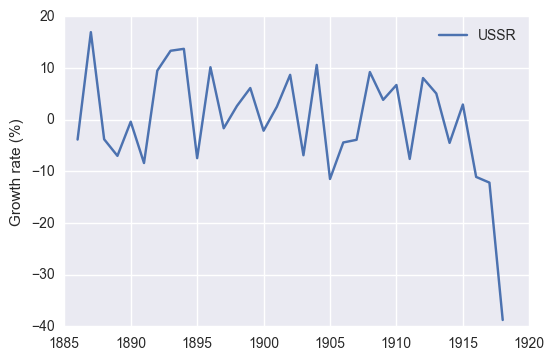
And from that we infer this:
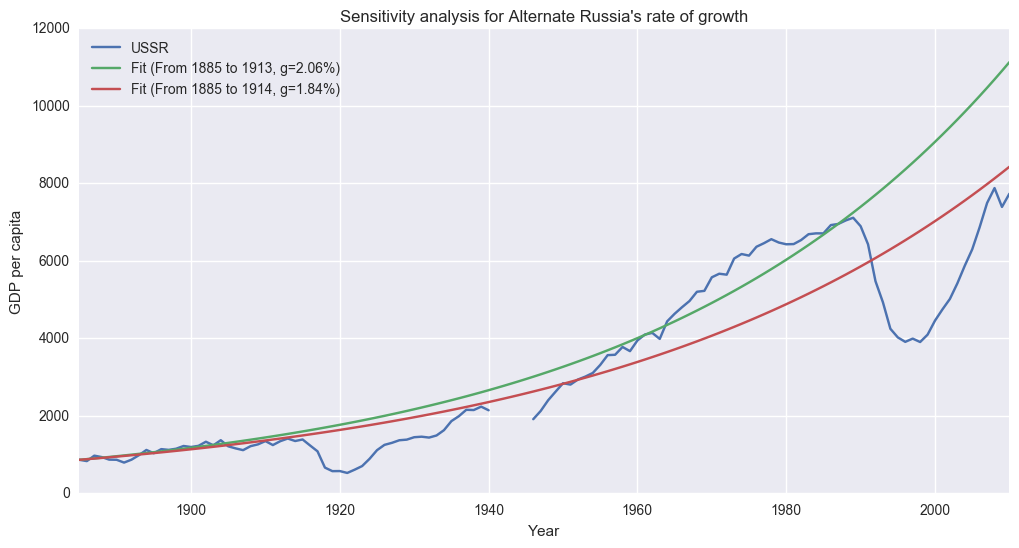
Considering more modern data, Tsarist Russia would have indeed kept pace with the Soviet Union, absent the revolution, had it kept its rate of growth. And here we are not assuming a change of institutions or even modern capitalism, just an extrapolation. I also provide the same fit, but considering one more year. This shows that the estimate of the yearly rate of growth is sensitive to the choice of years, it is not highly robust.
So it is a bit more likely than what Allen says that Russia without Stalin could have kept pace with its communist version. But the discussion is much more complicated. Allen devotes a whole chapter to pre-1917 growth, and gives reasons to expect that pre-1917 growth wouldn't have continued. However, we have seen that some of the economic historians who reviewed the book do think that it would have been possible, so the question is not fully settled here. My brief analysis only tips the balance a bit towards the optimistic case. Two more charts show a) the growth of countries that in the 1885-1913 showed the same rates of growth as the USSR, and b) Countries that in 1913 had similar GDP to the USSR (Or Russia before the actual USSR existed). These charts can be used to imagine possible futures that the USSR could have followed.
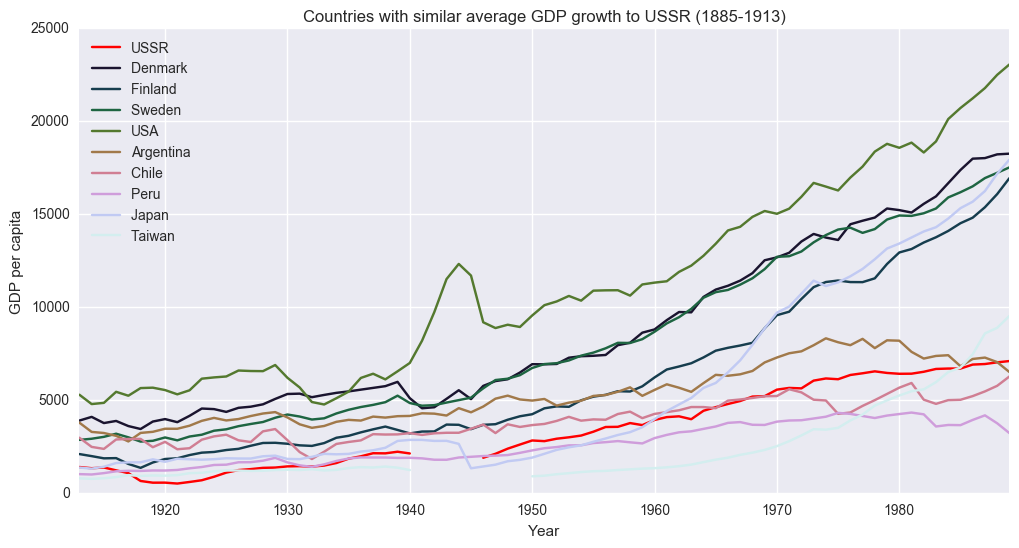
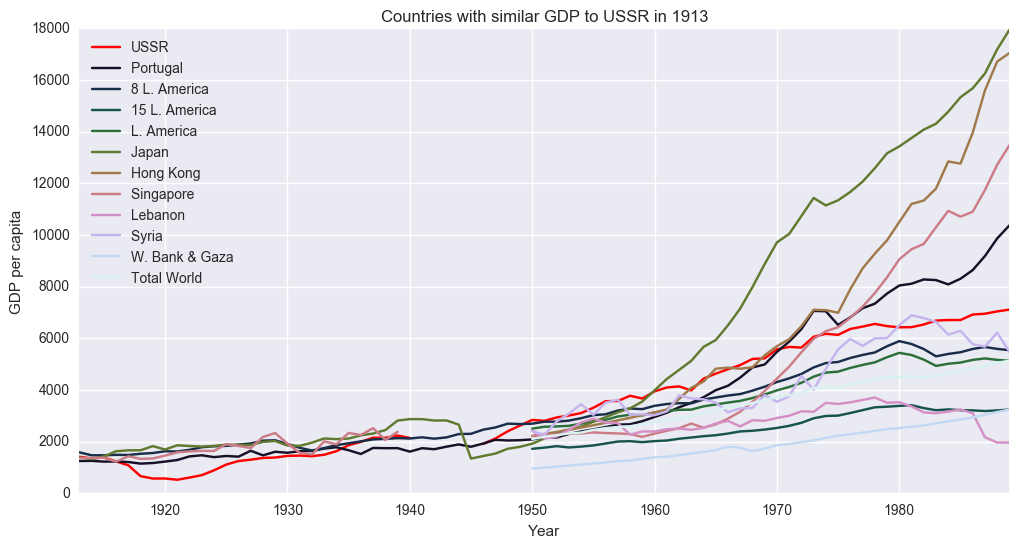 (The L. America items refer to different aggregations of LatAm countries. See Maddison's database)
(The L. America items refer to different aggregations of LatAm countries. See Maddison's database)
5. Recovery from the war?
I mentioned before that perhaps measuring the growth of the Soviet economy from 1928 onwards is biased because it could still be below the pre-revolution growth trend. If so, part of the growth achieved under Stalin would just be a recovery.
There are two post-Allen papers that try to address this issue. The first one is Markevich & Harrison (2011), who have this question among many they want to answer. And their answer to it is that:
In April 1929, when the Bolsheviks officially endorsed the “optimal” variant of the first Five-Year Plan, average incomes were still below the prewar level. In fact, Soviet GDP per head did not significantly exceed this benchmark until 1934. [...]
The prewar benchmark is an intuitive focal point for comparison, but is it the right one? Inspired by Ferenc Jánossy, the comparative literature on trend growth, war, and postwar catch-up suggests that productive potential does not stand still when war breaks out. From this point of view, the prewar benchmark is an excessively low bar. By 1928 fifteen years had passed since the outbreak of the Great War. If in the intervening period Russia’s potential GDP per head had risen along its modest pre-1913 log-linear trend of 1.74 percent per year, then at the endof the 1920s the actual still fell short of the potential by about one quarter.
Our results confirm that by 1928 economic recovery, measured by national income per head, was most likely still incomplete.
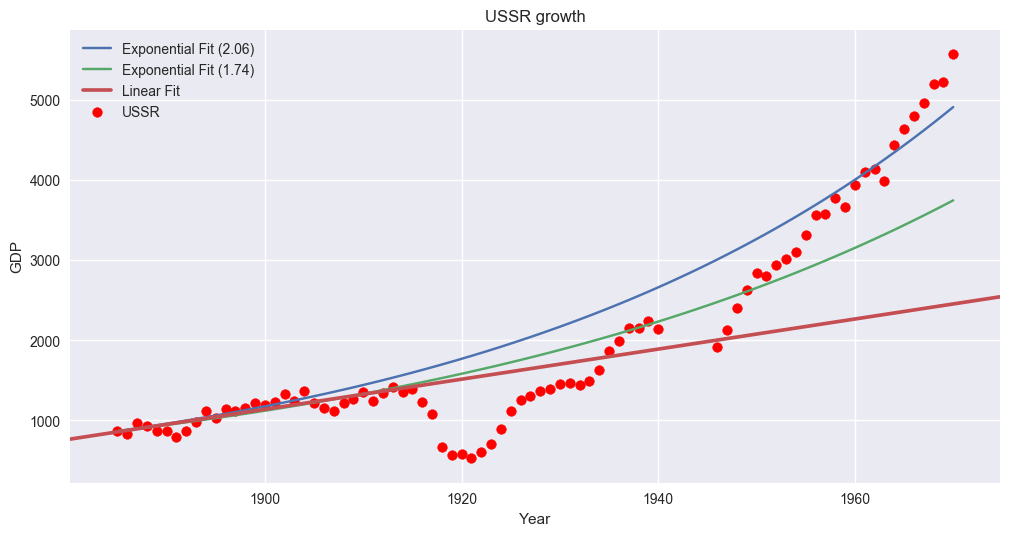
Here I use the average of the growth rates in 1885-1913 (2.06), plus the rate of growth that Markevich-Harrison give (1.74). By their average, recovery happened around 1937. By mine, until much later.
Wheatcroft (2009) denotes Allen's analysis as extremely optimistic. Among other things, Wheatcroft points to the fact that Allen under-estimates food consumption in the pre-revolutionary era by 15%, and consequently overestimate Soviet improvements. [6].
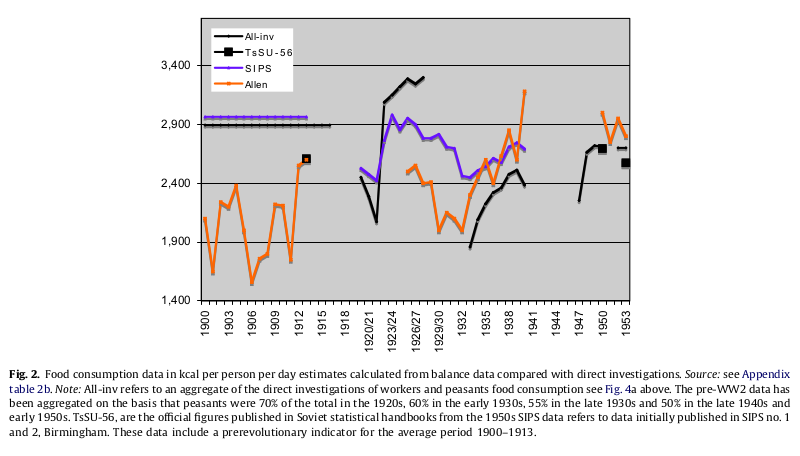
Here TsSU-56 are official Soviet figures published in 1956, SIPS refers to the Birmingham SIPS project data, compiled before nutritional surveys were available. Those take Soviet data, and then apply corrections to it. Finally, All-inv is data from nutritional surveys, and taken to be the best estimation.
The major differences between these series relates to the prewar data. The SIPS series was based on the survey work of Chayanov and Kabo. If it had been based on balancing utilization from the production data, then the pre-revolutionary grain production series would have needed an upward adjustment of about 19%. This would also have been required to make this figure more compatible with the inflated post 1926 expert Soviet evaluations of Soviet grain harvests. The history of the justification for this specific correction (the Ivantsov correction) has been referred to above and is explained in some detail in an earlier article (Wheatcroft, 1974). These conclusions are generally accepted by Gregory, Hunter and most specialists working in this area. Allen, however, appears to have used the inflated post 1926 data with the uncorrected prewar data. This would explain why his 1913 food consumption figure coincides with the official Soviet figure. If Allen’s figures had been correct it would have meant that food consumption levels in 1901, 1905, 1906, 1907, 1908, 1911 and all years before 1897 would have been lower, and often significantly lower than in the famine year of 1933! This is difficult to accept. If the appropriate corrected pre war data had been used the apparent growth in consumption across the whole period would turn into a decline, as is shown by all other sets of data. [...]
It is argued that Soviet nutritional surveys were the best in the world in the 1920s, and that remnants of this tradition remained throughout the 1930s. Contrary to the recent claims of Professor Allen nutritional levels, measured in calorific consumption fell from the pre-revolutionary period to the late 1930s and only began to rise in the late 1950s. On the other hand mortality data showed a continued sharp decline throughout this period in non-crisis years
Here's Allen initial 1928-1970 plot[7], plus a 1928-1989 plot for the same countries:

Here's the same plot, but this time starting in 1937. I chose this year, as this is the year that Markevich and Harrison would point out as the date of recovery:
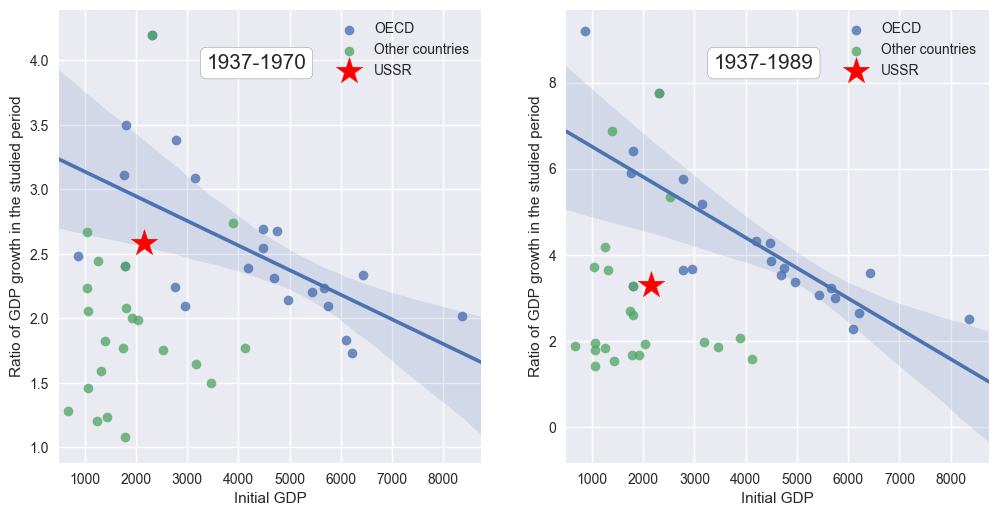
This doesn't look as impressive by OECD's standards.
6. A drop in civilian R&D?
One of the causes that Allen says caused the later stagnation of the Soviet Union was a decrease in civilian R&D motivated by an increase in military spending, a fraction of which was R&D. Allen argues that absent the Cold War, and keeping the rate of civilian R&D investment constant, Soviet GDP growth would have been 2 percentage points higher. The evidence cited for this is from 1986 and 1990.
Easterly and Fischer (1995) disregarded a drop in R&D as a cause of stagnation:
Another possible explanation for poor and declining Soviet growth could be adverse incentives under central planning for technological innovation (Berliner 1976). Recent theoretical and empirical literature argues that endogenous technological innovation, as measured by resources devoted to research and development (R&D), significantly explains relative growth performance across economies (Coe and Helpman 1993; Lichtenberg 1992; Romer 1989). Western estimates of the Soviet research effort, presented in figure 1, show R&D spending rising as a share of GDP. The R&D share is above the 2 to 3 percent of GDP in the leading industrialized economies. In 1967, about 1.5 percentage points of Soviet GDP was estimated to be for defense and space R&D (Bergson 1983). The share of defense and space R&D in total R&D is believed to have fallen in the period 1959-84 (Acland-Hood 1987), implying an even steeper rise in civilian R&D. It is well known that the lack of market incentives made the allocation of Soviet R&D inefficient and inhibited the diffusion of innovations. This would explain a low growth payoff for a given amount of R&D; it does not explain why that growth payoff would have fallen over time.
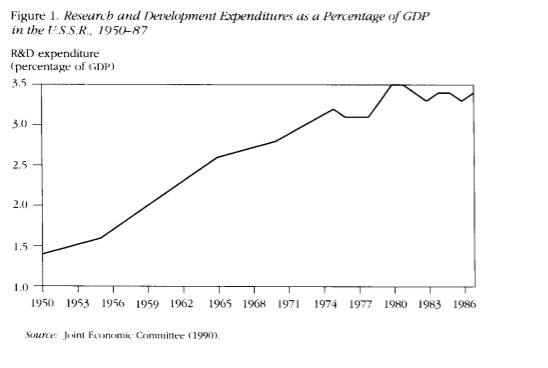
We can examine some sources of data. We have a CIA report for Soviet expenditures in R&D (1969). The reports open by saying that, actually, by 1969 the amount of R&D devoted to the civilian sector was increasing, not decreasing. And given that R&D tends to have a lagged effect on productivity, post 1970 decline in R&D wouldn't have caused an immediate drop in TFP in 1970.
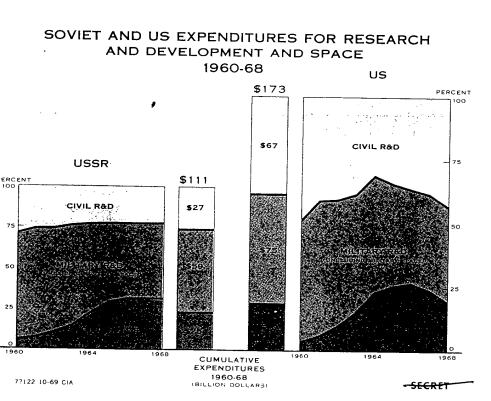
(The black area is civil space R&D spending)
Some could claim that, given this, then a decreasing share of military R&D was the cause of the decline, as military R&D is good for innovation(!). I've written elsewhere against the idea that military R&D and war more broadly drives innovation.
Interestingly, two of the references that Allen gives to back his claim that civilian R&D decreased, Kontorovich (1986,1990) have not been further discussed in the literature. They each have almost no citations. I could access the former, and Kontorevich argues that the decrease in civilian R&D productivity relative to military (measured by number of prototypes produced) began in 1960. And the data we have from CIA above does not indicate that civilian R&D had declined at that time. Kontorovich does not immediately attribute the fall in civilian R&D productivity to the cold war, but
Decline in R&D productivity has resulted from the interaction of three elements: the desire of the Soviet leadership to have a strong and productive R&D; specific characteristics of R&D activity that make it impossible to guide through purely bureaucratic, command procedures; failure of production management to guide applied R&D through their demand for innovations. The segment of R&D that expanded faster than the others was applied research and development subordinated to the ministries responsible for production in particular sectors.
But production I managers in a command economy are not interested in innovation, and hence, in the results of R&D. When the government flooded production ministries with resources earmarked for R&D, they started to engage in counterproductive practices. Research institutes were founded out of considerations of fashion and prestige, and without regard for need, availability of personnel, designers' time. Requirements concerning the formal side of I patent applications have increased. This and the increasing bias of the patent office in favor of planned inventions have squeezed out individual inventors, who usually generate the most radical ideas.
New planning and management procedures implemented in the 1979s increased the burden of reporting and record-keeping on R&D I personnel and led to an increase in the number of simple projects with a short payoff period, at the expense of creating radical innovations. Introduction of bonuses tied to the economic effect of implementation of innovations had the same effect. Finally, arbitrary determination of quotas for different kinds of personnel led to squeezing out technicians, blue collar workers, administrative, and clerical staff from R&D organizations; their functions have been increasingly discharged by scientists and engineers.
[...]
Military sectors are among the most technologically progressive (electronics, radio, aircraft). It may be the case that there was more opportunities for new design in these sectors than in the older ones such as metallurgy and mining; that R&D in defense sectors fared better because these sectors are more technologically progressive, not because they are defense. However, instruments, means of automation, and computers, which are no less technologically progressive than any of the military sectors, experienced a marked decline in the number of prototypes created. This suggests that R&D fared better in the military than in civilian machinebuilding because it was receiving a larger share of total resources: more and better researchers, designers, experimental and testing equipment. It may also be the case that R&D organizations in military machinebuilding have been using their resources more efficiently than their civilian counterparts, though I do not see why this should be so.
So Kontorovich has two reasons for the decline: The incentives of the planning system, and shifting resources towards the military sectors. He infers the latter from the decrease of prototypes created, but this contrasts with Acland-Hood(1987), cited by Easterly-Fischer, who says that the share of defense and military R&D actually fell during that period. If this is so, Kontorovich inference is wrong, and thus the cause of the fall in civilian inventions would be due to other reasons.
Here's a table from a SIPRI report that includes Acland-Hood's data, plus other estimates, which confirms indeed the share of military and space R&D was decreasing (So more of the increasing amount of R&D over GDP was civilian). This report mentions, and builds upon, Campbell's direct estimation, which is referenced in Allen's book. Allen does cite this report, but mysteriously he doesn't comment on this table.
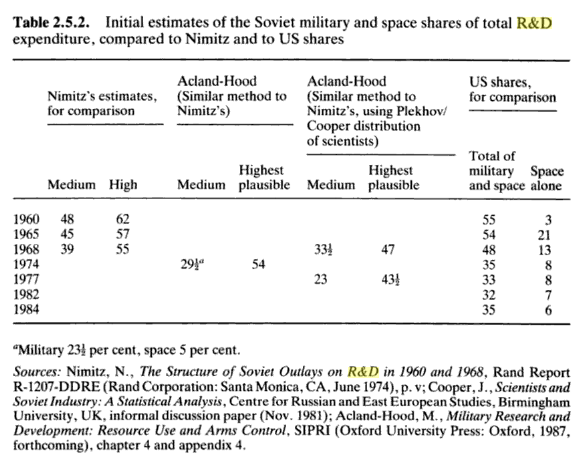
It does come out clear that, whatever way the adjustments are made, the share of military and space R&D in total R&D was falling from 1960 to the early 1970s ad falling or constant from then until 1977, but probably falling.
This is consistent with the CIA report, indicating Soviet intent in increasing investment in civilian R&D.
But if this is so, then either these measurements are wrong and CIA's assessment of Soviet intentions are wrong, or Kontorovich inference of declining civilian share of R&D from declining prototypes is wrong. Or perhaps, more resources were being allocated to R&D, but the best among those were increasingly being dedicated to military research.
As a compromise solution, pending further investigation, we could argue that the war effort played a role, but that it wasn't as big as Allen claims.
7. Some counterfactuals
Since the publication of the book, only one paper has done something close to challenging the main conclusions of it. Initially a working paper, it then developed into a proper peer-reviewed publication (Cheremukhin et al. 2016).
The debate about Stalin’s economic policies focuses exactly on these issues. Did Stalin’s industrialisation policies pay off in terms of economic welfare? Would Russia have industrialised without Stalin? Would Russia have done better without Stalin?
At the first glance (Figure 1), the data seem to be consistent with the Acemoglu and Robinson (2012) evaluation. They note that Stalinist industrialisation was “one brutal way” of unlocking “the economic potential for reallocating … labour from agriculture to industry” (Acemoglu and Robinson 2012). Russia outperformed its pre-1913 trend in per capita GDP, doubled its investment to GDP ratio, and moved about 30% of its labour force from agriculture to manufacturing and services.
On the other hand, these graphs do not necessarily prove that this transformation was driven by Stalin’s policies. It may well be the case that industrialisation and growth would have happened anyway. The graphs also do not tell us to what extent Soviet citizens benefitted from Stalin’s policies in the short- and in the long-run – compared to a reasonable counterfactual.
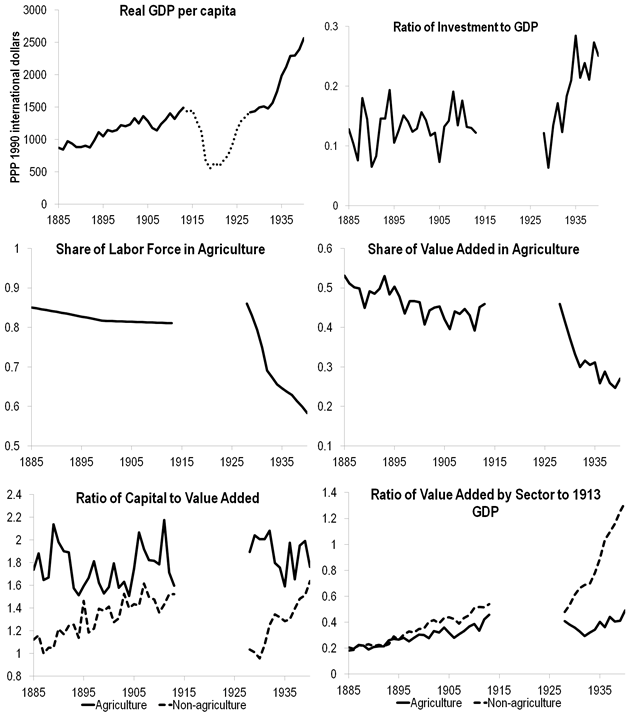
The paper essentially tries to examine deviations of the Tsarist and Soviet economyiesfrom a neoclassical model. They do it by analysing 'wedges', losses of efficiency due to a variety of reasons. They consider three sorts of wedges: intersectoral labour and capital wedges, and an intertemporal wedge. As an example, take the intersectoral labour wedge,
$latex \tau_{W,t}+1=\frac{U_{M,t}}{U_{A,t}}\frac{F_{N,t}^M}{F_{N,t}^A}$
Where U are the marginal utilities derived by an agent at time t, from the manufacturing and agricultural sectors, and F is the derivative of a Cobb-Douglas production function with respect to population. What the equation amounts to is saying that the nothing would be gained by redistributing labour between sectors.
In turn, they further decompose the labour wedge into a consumption, production, and mobility component. These measure that consumption, production, and the mobility of workers between sectors are optimal. The factors that could affect the wedges, generating inefficiencies, are:
- Peasant communes: After the abolition of serfdom, these were instituted. Some have argued that they would have restricted the mobility of workers, as they do not allow peasants to sell their land. Leaving the commune means surrendering your stake in it. This would appear in the mobility component of the labour wedge.
- Monopoly capitalism: Pre-revolutionary Russia to some extent was this. The State restricted competition, facilitating the appearence of inefficient monopolies. This would appear in the production component of the labour wedge.
- Segmented consumer markets, rationing: If transports and communications are suboptimal, prices will differ between different areas. This introduces a friction that prevents the equalisation of the marginal rates of substitution of agricultural/manufacturing goods and their relative prices. This increases the consumption component. Rationing and price controls would also increase/decrease the consumption component, depending on how the government sets prices.
- Industrialization and collectivization: If a monopolistic sector is pushed to produce more, beyond what a monopoly would, the production component of the labour wedge would decrease. Also, reducing the standards of living of agricultural workers, as collectivisation did would increase the wedge between the marginal product of labour in agriculture and their income. This would be reflected as an increase in income for the agricultural sector, and so reduce the production component too.
- "Big Push"[8]: Such a policy would increase manufacturing output and also increase the production component of the labour wedge.
What they find is that the labour wedge, especially the production component decreased, and that manufacturing TFP underperformed the trend from Tsarist times.
In the working paper, they engage in an analysis of the welfare implications, arguing that the losses outweighed the benefits, and come down quite strongly against Stalin - and Allen's thesis -
Therefore our answer to the ‘Was Stalin Necessary?’ question is a definite ‘no’. Even though we do not consider the human tragedy of famine, repression and terror, and focus on economic outcomes alone, and even when we make assumptions that are biased in Stalin’s favour, his economic policies underperform the counterfactual. We believe Stalin’s industrialisation should not be used as a success story in development economics, and should instead be studied as an example where brutal reallocation resulted in lower productivity and lower social welfare.
So from their analysis they conclude that first, extending Tsarist Russia into the future would have indeed resulted in lower growth compared to the Soviet Union (But higher welfare!) But second, implementing liberalising reforms in the Tsarist economy (Reducing barriers to entry, and increasing competition) would have been far superior. In the working paper they also consider implementing the Japanese model in Russia, and the conclusion is similar. Like Allen, they find that the NEP would also have been superior to Stalinism.
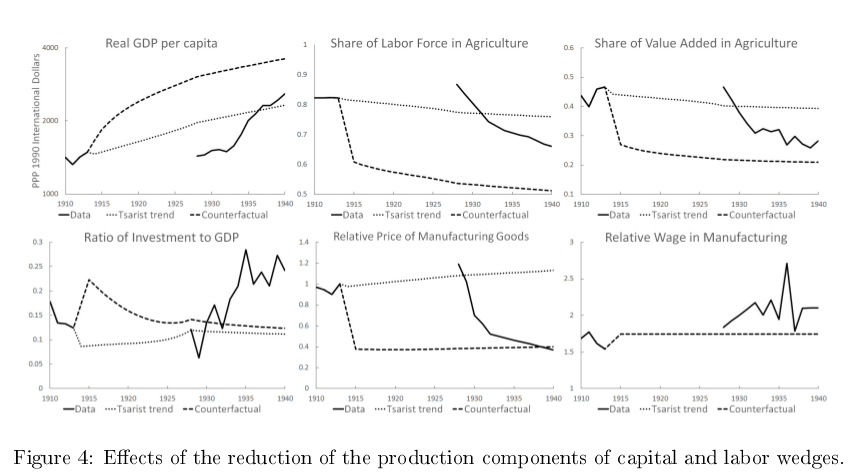
Finally, productivity (TFP) decreased during the first Five Year plan, and the authors do not find support for a Big Push interpretation of the effectiveness of Stalin's policies, and neither do they find support for the theory that movement of workers from rural areas to cities during the Tsarist period did not happen because to institutional (communes orobschina) factors.
Our findings are inconsistent with the predictions of Big Push theories that sweeping state investments should increase productivity in the manufacturing sector and increase the labor wedge (see Section 3.2). We observe exactly the opposite. The labor wedge signicantly decreased. TFP fell in both sectors during the main phases of industrialization and collectivization and remained below Tsarist trends in most years.
Our results are also not consistent with the view that collectivization policies played a major role in changing intersectoral distortions: we show that the decrease in the production component was mostly driven by the reduction of markups in the non-agricultural sector rather than by the increase in markups in argiculture. At the same time, our ndings lend support to the view that policies that encouraged expansion of manufacturing, e.g., through the use of explicit output targets, soft budget constraints, etc., signicantly aected intersectoral allocation of resources.
For Cheremukhin et al., Stalinism worked like it did not because of anything particular inherent to central planning, but because it fixed the problems of Tsarism by means of forcing the transition from farms to factories.
One final interesting feature of this paper is that it tries to solve a defect that plagues any economic history analysis that has low quality or scarce data as an input: That the conclusions can be highly dependent on the choice of model, choice of price index, or ways of estimating missing values. The conclusions that follow from their model, though, can be written in terms of directly measured data, and so the authors claim that their conclusion will hold under any reasonable alternative way of analysing the data
All these results characterize the rates of change of distortions. We show below that these rates can be written in terms of directly measurable economic aggregates in a way that either does not include any parameters of the model at all, or includes only a small number of parameters. This implies that our broad conclusions should be robust to a wide range of model specifications.
Conclusion
Given the above analysis, I come to the following conclusions:
- Stalinism managed to grow GDP faster than Tsarist Russia, but the price in terms of welfare to pay for that growth was probably not worth it. [9]
- Liberalising reforms in Tsarist Russia would have probably led to even faster growth. However, it is difficult to know if it is plausible that those reforms would have been actually implemented given the institutional setting. Allen's claim that absent Stalin, Russia would have been a country with a level of income similar to Latin America cannot be ruled out.
- The secret sauce of Soviet growth is the increase of the investment share of GDP, and forcing the transition from agriculture to industry. Not central planning.
- Most of the spectacular Soviet growth was achieved before World War II, and could be attributed to a recovery from the civil war.
- The consensus explanation for the later stagnation of the Soviet Union is largely correct: central planning does have incentive and information problems, and growth by increasing inputs (capital and labour) alone is not sustainable without accompanying increases in productivity. The cold war could have been a, but not the, factor explaining that decrease in productivity.
- Further research is needed. Other experiences with central planning should be analysed to see if, at least, they are an effective growth model for poor countries versus the benchmark of a market economy.
Notes
[1] Truth be told, one also has to take into consideration the Land Lease programme, and engage in the appropriate counterfactuals. It is my belief that the war against Nazi Germany was winnable without the Soviet Union (The US had far more productive capacity), and that the advance of the Soviet Union would have been severely delayed but not stopped, without the land lease programme. So while in a way you can say that the USSR was the biggest responsible for winning World War II both in terms of resources employed and chunks of Germany's armies defeated, we should not take this to imply that such a role was a necessity.
[2] Think of it in terms of GDP vs potential GDP. Altough I think that the concept does not apply during recessions. Recessions mean that the capital structure of an economy has to readapt, there is no previous state of the economy that is stable achievable after a recession. Thus recoveries will always be slower than crashes.
[3] That is, if I'm forced to save more now, plausibly the future me will enjoy more things. But that will come at my expense. Even if higher growth is achievable by coercively increasing investment, that may not be what people want.
[4] As for example Bryan Caplan (2005) believed or used to believe.
[5] And military spending, but that was a bit more of an external necessity given the geopolitics of the Cold War.
[6] Allen seems to rely on FAO data for his calories, something that I criticised here. But this doesn't affect his argument, as my suggested adjustment would only drive the whole series down, so the rates of growth are unaffected.
[7] See the chart appendix for what countries are in each category
[8] This is the idea that a free market can get stuck in a low development equilibrium due to coordination problems (e.g. companies don't build petrol stations because people have no cars, and people don't buy cars because there are no petrol stations), and that a government, via investing in key areas, generally infrastructure, can shift the equilibrium to a high development one.
[9] This measure excludes famine, repression, and terror, so it is biased in favour of Stalin, but it is what Cheremukhin et al. used.
Therefore our answer to the ‘Was Stalin Necessary?’ question is a definite ‘no’. Even though we do not consider the human tragedy of famine, repression and terror, and focus on economic outcomes alone, and even when we make assumptions that are biased in Stalin’s favour, his economic policies underperform the counterfactual. We believe Stalin’s industrialisation should not be used as a success story in development economics, and should instead be studied as an example where brutal reallocation resulted in lower productivity and lower social welfare.
Bibliography
Allen, R. C. (2003). Farm to factory: A reinterpretation of the Soviet industrial revolution. Princeton University Press.
Allen, R. C. (2005). A Reassessment of the Soviet Industrial Revolution. Comparative Economic Studies, 47(2), 315-332.
Caplan, B. (2005). Toward a new consensus on the economics of socialism: Rejoinder to my critics. Critical Review.
CIA (1969) Soviet Expenditures for Research and development. Released in 1998.
Cheremukhin, A., Golosov, M., Guriev, S., & Tsyvinski, A. (2013). Was Stalin Necessary for Russia's Economic Development? (No. w19425). National Bureau of Economic Research.
Cheremukhin, A., Golosov, M., Guriev, S., & Tsyvinski, A. (2016). The Industrialization and Economic Development of Russia through the Lens of a Neoclassical Growth Model. The Review of Economic Studies
Davies, R.W. (2004) Book Review, From Farm to Factory. EH.net (Accessed 24-01-17)
Ellman, M. (2004) Soviet Industrialization: A Remarkable Success? Slavic Review
Harrison, M. (2004). Book Review, From Farm to Factory The Russian Review, 63(4), 715-717.
Jacobsen, C. G. (1987). The Soviet Defence Enigma: Estimating Costs and Burden. Stockholm International Peace Research Institute.
Kontorovich, V. (2015). The military origins of Soviet industrialization. Comparative Economic Studies, 57(4), 669-692.
Markevich, A., & Harrison, M. (2011). Great War, Civil War, and recovery: Russia's national income, 1913 to 1928. The Journal of Economic History, 71(03), 672-703.
Graphical Appendix
Find it here
Comments from WordPress
:) 2017-02-11T18:43:32Z
Great post! The best of Soviet series!
In my opinion, I think that the comparison Eastern Europe vs Southern Europe (periphery vs. periphery) clearly shows the failure of the planned economy, the growth of the countries of Eastern Europe wasn't only minor but also unsustainable
The Soviet Union and the countries of Eastern Europe lost a great opportunity to converge with the West, and in the case of the USSR, it wasn't even able to surpass in growth and welfare the old regime!
Well, it seems that there's nothing left to continue the Soviet series, no?
- The Soviet Union series | Nintil 2017-02-04T19:39:26Z
[…] The Soviet Union: From farm to factory. Stalin’s industrial revolution. […]
- The Soviet Union: GDP growth | Nintil 2017-02-04T19:40:35Z
[…] An analysis of Allen’s book can be found here […]
Lorenzo from Oz 2017-02-05T08:01:57Z
I am surprised by the lack of reference to Mancur Olson and his (posthumous) Power and Prosperity, where he argued that purges enabled Stalinism to work by counteracting the negative incentive and information effects of command-and-control.
When you consider the wartime resources transferred to the USSR (including trucks, rolling stock and canned food), the bleeding off of the Luftwaffe to defend Germany and all those potential tank-busting 88mm guns pointing upwards to shoot Anglo-American aircraft and not Eastwards to bust tanks, "winning the war almost single-handedly" seems a gross exaggeration even as an off-hand comment.
"Not worth the welfare effects"? What is the mass death trade-off for economic growth?
On the other hand, great summary and discussion of the scholarly debate.
Artir 2017-02-07T11:43:31Z
Thank you for your comments.
On a second thought, I toned down the comment re winning WWII, as it sounds controversial, and I'm not arguing for that point here, and I don't even strongly endorse it. My thoughts about that come from the evaluation that collectively the guys over at the AskHistorians reddit did.
I also clarified what I meant by welfare there. Personally, even if Stalin had caused higher GDP than otherwise, I wouldn't have endorsed his methods.
I glossed over the question of incentives largely for length reasons (I also considered discussing other attempts at forced industrialisation, there is an interesting paper about that ("Soviet power plus electrification: What is the long-run legacy of communism?"). Kornai also mentions that those control mechanisms were effective during Stalinism, and that the softening in coercion from the top after Stalin had a negative impact on the workings of central planning.
Thomas 2017-09-19T11:54:01Z
Once you show data like this it becomes quite obvious the Russian Empire was a declining power https://cont.ws/uploads/pic/2016/12/311.gif
Artir 2017-09-23T08:43:42Z
I don't know where that comes from. I have been using data from Maddison for the same time period, and it is widely considered as one of the best available sources for crosscountry and across time comparisons of GDP
Thomas 2017-09-25T18:47:23Z
Well, my graph also sources Maddison, including this one coming from a Western website. https://gyazo.com/20710b3dfd1c5a62e4b556b71a20883c There is a reason there was a revolution, the Russian Empire was not sustainable and was a declining power.
Thomas 2017-09-25T18:49:44Z
https://imgur.com/edit?deletehash=wujZCO0RytVqcPp&album_id=wB841
Thomas 2017-09-19T11:49:10Z
Why are you not accounting for WW1 in your graph? https://artir.files.wordpress.com/2017/01/descarga-11.png?w=640 Are the communists also responsible for it?
So your Soviet model works with the destruction of Russia in all of those wars, yet your 'Czarist' model does not, that is an extreme dishonesty. We could maybe not count the civil war (which would have happened nevertheless, do you honestly think none of these imprisoned nations would actually fight for independence?) and WW2, but in no way you could not count WW1 and think you are producing anything honest here.
This blog is a fraud.
Artir 2017-09-23T08:45:55Z
I exclude WWI, and so does Allen to be kind to the Tsars: Growth dropped during WWI. If I include it, growth would drop. Similarly, if I had data for the Soviet Union during WWII, I would exclude it from the fit. I am evaluating the economic system, net of exogenous shocks.
Thomas 2017-09-25T18:46:03Z
Then you are not comparing the USSR with the Russian Empire, are you? Not to mention the Czar among others started the World War, Russia did not have to take part.
John Meyers 2017-06-27T03:52:18Z
"Truth be told, one also has to take into consideration the Land Lease programme, and engage in the appropriate counterfactuals. It is my belief that the war against Nazi Germany was winnable without the Soviet Union (The US had far more productive capacity), and that the advance of the Soviet Union would have been severely delayed but not stopped, without the land lease programme. So while in a way you can say that the USSR was the biggest responsible for winning World War II both in terms of resources employed and chunks of Germany’s armies defeated, we should not take this to imply that such a role was a necessity."
Productivity alone does not win wars. The western allies struggled against the lower quality divisions of the Wehrmacht, we have absolutely no reason to believe that they would have been able to win land battles against the full force of the Wehrmacht. Furthermore, most of Germany's military production was focused on building tanks, artillery, support aircraft, firearms etc. for the Eastern Front. If the Soviet Union had been defeated earlier, or never entered the war, it would have been far more difficult for the western allies to gain air supremacy or even superiority. Remember they only gained air supremacy mid 1944, when the German armies were collapsing in the east. If Germany was able to install more anti aircraft defenses like the ones built to stop Ploesti from being bombed, would the allied strategic bombing campaign be effective? it was already minimally effective in 1944, when German industrial output actually increased significantly.
Armies * Productive capacity is what wins wars.
Thomas 2017-09-19T11:50:49Z
Without the USSR there would be no WW2. The only purpose of the war was to crush the USSR. Without the USSR the West would be likely allied with Hitler.
Citation
In academic work, please cite this essay as:
Ricón, José Luis, “The Soviet Union: From farm to factory. Stalin's Industrial Revolution”, Nintil (2017-02-04), available at https://nintil.com/the-soviet-series-from-farm-to-factory-stalins-industrial-revolution/.


